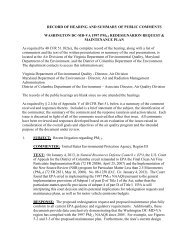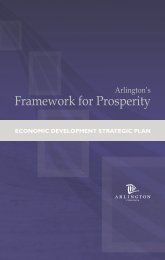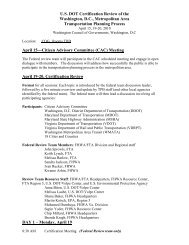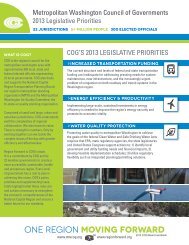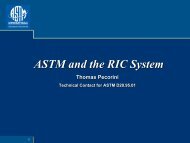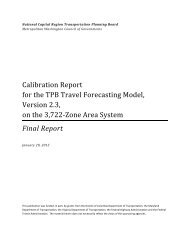PTI Local Government Energy Assurance Guidelines - Metropolitan ...
PTI Local Government Energy Assurance Guidelines - Metropolitan ...
PTI Local Government Energy Assurance Guidelines - Metropolitan ...
Create successful ePaper yourself
Turn your PDF publications into a flip-book with our unique Google optimized e-Paper software.
media in their effort to respond to energy emergencies. With a few notable exceptions (e.g. Chicago, Philadelphia,<br />
New York, or other cities located near ports, nuclear reactors, refineries, and other major energy infrastructure),<br />
communication with key energy industry representatives generally has received less emphasis from local<br />
governments. <strong>Local</strong> planners may want to consider being more inclusive of these other stakeholders in developing<br />
and implementing communication and outreach protocols as part of their EAPs.<br />
Adding the electric, natural gas, petroleum, and other major energy industries to the communications network before,<br />
during, and after an energy emergency is good business. It is important that both the message and response efforts be<br />
coordinated with these stakeholders.<br />
Dissemination of Accurate Information<br />
The media can play a helpful role in assisting local governments prior to an energy emergency by disseminating<br />
information about preparedness and response ahead of time. The key to preventing panic during an energy<br />
emergency is to disseminate accurate information as quickly as possible to the general public, and to any other<br />
potentially affected entities, using the media where appropriate. This information dissemination will involve many<br />
topics, including:<br />
■■<br />
■■<br />
■■<br />
Public assistance programs where the general public may obtain needed resources<br />
The scope, severity, and potential duration of the energy disruption<br />
Regional and State energy resource-specific contingency plans<br />
Use of Social Media/Web-Based Communication<br />
Posting energy-related information on the local government website during a crisis is not only an important part of<br />
communicating with the media and the public, but also can establish a valuable link to other local, State, and Federal<br />
government departments, as well as non-governmental organizations (NGOs) and associations that are affected<br />
by or involved in the management of the energy crisis. The energy assurance coordinator may want to establish<br />
relationship with the local government webmaster and public information officer (or equivalent personnel) to<br />
establish the types of web materials that will be required, and desired in a future energy emergency. Obviously, this<br />
means of communication will only be viable if electricity is still operational and the Web is accessible. The important<br />
point here is that jurisdictions need to plan for and enable all forms and means of communication prior to an event<br />
so that if/when one communication mode is rendered inoperable there remain other viable, backup communications<br />
systems.<br />
Most local governments are using social media such as YouTube, Facebook, and Twitter, albeit primarily as<br />
marketing channels for their communities. It is very common to find these social media sites listed on city and<br />
county homepages. These same sites can be useful channels for sending out current and accurate information during<br />
an energy emergency. Texting is an increasingly important form of communication across many age groups, and as<br />
such needs to be considered a key part of an EAP communication strategy. When an emergency occurs, the public<br />
may communicate via texting, email, and other just-in-time communications options. <strong>Local</strong> planners should be wellversed<br />
in these and social media sites as well such as Facebook and Twitter. These media provide an inexpensive,<br />
effective way to reach many people quickly. These same methods can also be used for service restoration activities;<br />
local governments can develop free mass text notification services and e-alerts for emergency situations and events,<br />
to which constituents can subscribe to receive status updates.<br />
64 | 3 – How to Develop or Enhance a <strong>Local</strong> <strong>Energy</strong> <strong>Assurance</strong> Plan



